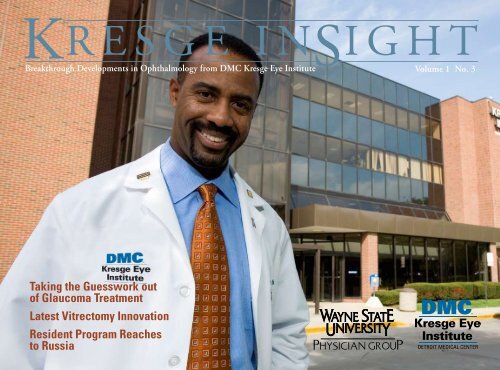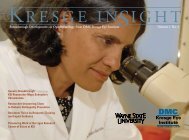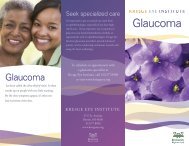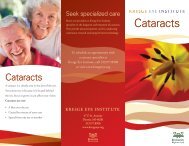resge in ight - Kresge Eye Institute
resge in ight - Kresge Eye Institute
resge in ight - Kresge Eye Institute
- No tags were found...
You also want an ePaper? Increase the reach of your titles
YUMPU automatically turns print PDFs into web optimized ePapers that Google loves.
SKBreakthrough Developments <strong>in</strong> Ophthalmology from DMC K<strong>resge</strong> <strong>Eye</strong> <strong>Institute</strong>R E S G E I N I G H TVolume 1 No. 3Tak<strong>in</strong>g the Guesswork outof Glaucoma TreatmentLatest Vitrectomy InnovationResident Program Reachesto RussiaDETROIT MEDICAL CENTER
W elcome to DMC K<strong>resge</strong> <strong>Eye</strong> <strong>Institute</strong>This edition of InS<strong>ight</strong> is very special as it co<strong>in</strong>cides with the60th anniversary of K<strong>resge</strong> <strong>Eye</strong> <strong>Institute</strong>. S<strong>in</strong>ce 1948, K<strong>resge</strong>has truly been a leader <strong>in</strong> ophthalmologic care, research,and medical education – and we are not slow<strong>in</strong>g down. Thestories we will share with you this time around are reflectiveof the quality that has been a hallmark of K<strong>resge</strong> for the pastsix decades.In this edition we feature our unique partnership withbasic scientists at Wayne State University, the <strong>in</strong>tegratednature of which facilitates a collaborative approach togroundbreak<strong>in</strong>g research. One example of the collaboration is Gabriel Sosne, M.D.,a comprehensive ophthalmologist with an active cl<strong>in</strong>ical practice who also performslaboratory research <strong>in</strong> Scott Hall at the Wayne State University School of Medic<strong>in</strong>e.Dr. Sosne is translat<strong>in</strong>g the results of his laboratory <strong>in</strong>vestigation on a substancethat promotes heal<strong>in</strong>g of corneal wounds to a cl<strong>in</strong>ical trial on patients with cornealerosions follow<strong>in</strong>g vitrectomy surgery. Important cl<strong>in</strong>ical research is be<strong>in</strong>g led byK<strong>resge</strong> <strong>Eye</strong> <strong>Institute</strong> glaucoma specialist Dr. Bret Hughes. Dr. Hughes recentlyserved as KEI pr<strong>in</strong>cipal <strong>in</strong>vestigator <strong>in</strong> the NIH Ocular Hypertension TreatmentStudy -- the largest-ever national longitud<strong>in</strong>al study of high eye pressure and thedevelopment of glaucoma. Prelim<strong>in</strong>ary results from the study show that <strong>in</strong> AfricanAmericans pressure-lower<strong>in</strong>g eye drops reduce the development of primary openangle glaucoma by almost 50 percent. Dr. Hughes is a national leader <strong>in</strong> glaucomaresearch and has received the American Academy of Ophthalmology AchievementAward.In addition to new research, our physicians cont<strong>in</strong>ue to lead the way with<strong>in</strong>novative applications of exist<strong>in</strong>g technology and treatments. In this edition youwill see just a few examples: Dr. Gregory Van Stavern is us<strong>in</strong>g optical coherencetomography (OCT) to track the progression of multiple sclerosis. Ret<strong>in</strong>a specialistTamer Mahmoud, M.D. skillfully used a fluoc<strong>in</strong>olone <strong>in</strong>travitreal implant <strong>in</strong> abreakthrough multi-procedure surgery which restored vision <strong>in</strong> a patient bl<strong>in</strong>dfrom complications of severe uveitis. Dr. Asheesh Tewari is work<strong>in</strong>g with devicemanufacturers to develop and test a new generation of vitrectomy <strong>in</strong>strumentation.K<strong>resge</strong> ophthalmologists also cont<strong>in</strong>ue to be global teachers. S<strong>in</strong>ce the 1990s, Dr.James Pukl<strong>in</strong> has been <strong>in</strong>strumental <strong>in</strong> br<strong>in</strong>g<strong>in</strong>g ophthalmologists from Russiato study at K<strong>resge</strong>. In this edition you will hear the experience from one of thesephysicians currently here to conduct research on artificial vision.I am truly honored to share with you these latest breakthroughs <strong>in</strong> research andcl<strong>in</strong>ical care. As always, I <strong>in</strong>vite your comments and observations and can bereached at gabrams@med.wayne.edu.Dr. Gary AbramsDirector, K<strong>resge</strong> <strong>Eye</strong> <strong>Institute</strong>The David Barsky, MD Professor and Chair of OphthalmologyWayne State University School of Medic<strong>in</strong>e
K<strong>resge</strong> <strong>Eye</strong> <strong>Institute</strong> SpecialistsGary W. Abrams, M.D.Vitreoret<strong>in</strong>al Diseasesand SurgeryMonica Y. Alexander, M.D.GlaucomaEvan H. Black, M.D.Oculoplastics andOrbital SurgeryChristopher J. Cheyer, M.D.Oculoplastics andOrbital SurgeryRobert N. Frank, M.D.Medical Diseasesof the Ret<strong>in</strong>aConrad L. Giles, M.D.Pediatric OphthalmologyAnju Goyal, M.D.GlaucomaBret A. Hughes, M.D.GlaucomaRaymond Iezzi, M.D.Vitreoret<strong>in</strong>al Diseasesand SurgeryJo D. Issacson, M.D.ComprehensiveOphthalmologyMark S. Juzych,M.D., M.H.S.A.GlaucomaTamer H. Mahmoud, M.D., Ph.D.Vitreoret<strong>in</strong>al Diseasesand SurgerySusan H. McCutcheon,O.D.Well <strong>Eye</strong> CareMark L. McDermott,M.D., M.B.A.Cataract and CornealSurgeryPatrick L. Murphy, M.D.Vitreoret<strong>in</strong>al Diseases andSurgeryJames E. Pukl<strong>in</strong>, M.D.Vitreoret<strong>in</strong>al Diseasesand SurgeryJohn M. Ramocki, M.D.Oculoplastics,Comprehensive Ophthalmologyand Cataract SurgeryJohn D. Roarty, M.D.PediatricOphthalmologyGabriel Sosne, M.D.Cataract Surgeryand ComprehensiveOphthalmologyAsheesh Tewari, M.D.Vitreoret<strong>in</strong>al Diseasesand SurgeryGregory P. Van Stavern, M.D.Neuro-OphthalmologyJayne S. Weiss, M.D.Refractive, Corneal andCataract SurgeryElizabeth Hakim Yates, O.D.Well <strong>Eye</strong> Carewww.dmc.org
Partnership Expands Research, Recruit<strong>in</strong>gS<strong>in</strong>ce 1966 DMC K<strong>resge</strong> <strong>Eye</strong> <strong>Institute</strong> and Wayne State UniversitySchool of Medic<strong>in</strong>e have been partners, with K<strong>resge</strong>’s cl<strong>in</strong>icalophthalmologists manag<strong>in</strong>g care at WSU and DMC, as well asserv<strong>in</strong>g as WSU faculty members. Many staff members hold jo<strong>in</strong>tappo<strong>in</strong>tments at K<strong>resge</strong> and WSU’s Department of Anatomy andCell Biology.While both organizations haveemphasized research, a fewyears ago K<strong>resge</strong>’s director, GaryW. Abrams, M.D., and L<strong>in</strong>daD. Hazlett, Ph.D., dist<strong>in</strong>guishedprofessor and chair, WSUDepartment of Anatomy andCell Biology, decided that morecould be done to <strong>in</strong>tegrate theirefforts.“Traditionally, the basic sciencedepartments <strong>in</strong> medical schoolshave focused on the mechanisms ofbiologic processes and diseases. Thecl<strong>in</strong>ical departments have physicianswho treat and study the cl<strong>in</strong>ical aspects of disease,” says Dr. Abrams. “A few yearsago we looked at try<strong>in</strong>g to <strong>in</strong>tegrate all vision research so that basic and cl<strong>in</strong>icalresearch was better focused on creat<strong>in</strong>g solutions for people with vision problems.”Dr. Hazlett noted that WSU and K<strong>resge</strong> “had common goals <strong>in</strong> vision researchand common needs for faculty recruitment.”“It’s been a very productive <strong>in</strong>teraction that has allowed us to enhance research atboth <strong>in</strong>stitutions,” comments Dr. Abrams. “We’ve become the model for otherdepartments at Wayne State, which are now look<strong>in</strong>g to l<strong>in</strong>k basic science departmentswith cl<strong>in</strong>ical departments.”As recognition of their success, the departments were co-recipients of a 2004 GraduateProgram Enhancement Award fromthe WSU Provost, allow<strong>in</strong>g them to recruitnew staff. Researchers hired as a result ofthat fund<strong>in</strong>g have developed protocolsthat are now show<strong>in</strong>g promis<strong>in</strong>g results <strong>in</strong>national cl<strong>in</strong>ical trials.The partnership has also allowed the twoto attract numerous grants from the National<strong>Institute</strong>s of Health and the National<strong>Eye</strong> <strong>Institute</strong>, such as a $2.091 millionCore Center grant. This grant, for whichDr. Hazlett serves as the PI, provides facilitiesand state-of-the-art <strong>in</strong>strumentationto foster further research efforts <strong>in</strong> vision.Only 35 centers <strong>in</strong> the United Stateshave received a Core Center grant, whichrequires e<strong>ight</strong> R01 research grants to apply.Investigators <strong>in</strong> vision from WayneState, Michigan State, Oakland University,University of Chicago and Penn State are active participants, hold<strong>in</strong>g 19 NEI R01research grants.“Our goal is to take our f<strong>in</strong>d<strong>in</strong>gs from the lab <strong>in</strong>to the cl<strong>in</strong>ic, us<strong>in</strong>g the strong<strong>in</strong>teractions among our basic and cl<strong>in</strong>ical scientists to perform translational researchwith the goal of mak<strong>in</strong>g mean<strong>in</strong>gful advances <strong>in</strong> patient care,” Dr. Abrams says.
Track<strong>in</strong>g Multiple SclerosisProgression with OCTOften, optic neuritis, or <strong>in</strong>flammation of the optic nerve,is the first reported symptom that leads to a diagnosis ofmultiple sclerosis. Accord<strong>in</strong>g to the National MultipleSclerosis Society, 55 percent of people with MS will havean episode of optic neuritis.A researcher at KEI is work<strong>in</strong>g on several fronts to f<strong>in</strong>d treatments for MS and away to predict disease progression. Gregory Van Stavern, M.D., associate professor<strong>in</strong> the departments of Ophthalmology, Neurology and Neurosurgery, is an <strong>in</strong>vestigator<strong>in</strong> the FREEDOMS study, a Phase III cl<strong>in</strong>ical trial to evaluate the effectivenessand safety of f<strong>in</strong>golimod. Begun <strong>in</strong> 2006, the 24-month study has enrolled 1,250patients worldwide. Results of the Phase II study were released <strong>in</strong> April and showednearly 70 percent of MS patients tak<strong>in</strong>g f<strong>in</strong>golimod were relapse free after threeyears of daily oral treatment.Dr. Van Stavern is us<strong>in</strong>g optical coherence tomography (OCT) as an outcomemarker <strong>in</strong> the trial. “OCT can track the damage to axons and myel<strong>in</strong> <strong>in</strong> the opticalnerve fibers to see if the disease is progress<strong>in</strong>g. In addition, OCT is faster, cheaperand more repeatable than MRI studies.“Ideally, we could use OCT to predict theprogression of MS, prevent attacks withmedication and prevent long-term disability.”Optical coherence tomography, or OCT, is a non-<strong>in</strong>vasivetechnique commonly used to obta<strong>in</strong> high-resolutionimages of the ret<strong>in</strong>a. OCT can measure the ret<strong>in</strong>al nervefiber layer thickness that may change with glaucoma andother diseases of the optic nerve. Dr. Van Stavern is nowus<strong>in</strong>g it to track progression of optical nerve damage <strong>in</strong>multiple sclerosis patients.www.dmc.org
T ak<strong>in</strong>g the Guesswork Out of Glaucoma TreatmentA National <strong>Institute</strong> of Health study just conclud<strong>in</strong>g has takensome of the guesswork out of treat<strong>in</strong>g glaucoma. Glaucomais elevated eye pressure which can cause damage to the opticnerve, result<strong>in</strong>g <strong>in</strong> bl<strong>in</strong>dness. The largest-ever longitud<strong>in</strong>alstudy of high eye pressure and the development of glaucoma --the Ocular Hypertension Treatment Study (OHTS) -- studied1,637 patients at medical centers nationwide, <strong>in</strong>clud<strong>in</strong>gDMC K<strong>resge</strong> <strong>Eye</strong> <strong>Institute</strong>.“OHTS sought to prove if us<strong>in</strong>gmedication <strong>in</strong> the form of eyedrops to lower eye pressure preventsor delays the developmentof primary open-angle glaucoma<strong>in</strong> people with ocular hypertension,”says Bret A. Hughes, M.D.,associate professor of ophthalmologyat Wayne State UniversitySchool of Medic<strong>in</strong>e and pr<strong>in</strong>cipal<strong>in</strong>vestigator for the OHTS studyat KEI. “OHTS also identifiedrisk factors for the developmentof glaucoma. In addition it helpedcl<strong>in</strong>icians estimate, based on risk, which patients m<strong>ight</strong> benefit from earlyprophylactic medical treatment, prevent<strong>in</strong>g vision loss.”Previous studies had not conclusively proven that treatment delayed or preventedglaucoma, however those studies had design problems.Begun <strong>in</strong> 1996, OHTS first followed patients randomized <strong>in</strong>to treatment andobservation groups for five years. In 2002, the study published <strong>in</strong>itial results <strong>in</strong> theArchives of Ophthalmology show<strong>in</strong>g that us<strong>in</strong>g eye drops to lower eye pressure waseffective <strong>in</strong> delay<strong>in</strong>g or prevent<strong>in</strong>g the onset of POAG.Because glaucoma is a lead<strong>in</strong>g cause of bl<strong>in</strong>dness and visual impairment amongAfrican Americans, researchers wanted a more def<strong>in</strong>itive answer about the effects ofearly treatment <strong>in</strong> this subgroup. After <strong>in</strong>itial results, researchers cont<strong>in</strong>ued to followthe African Americans <strong>in</strong> OHTS. F<strong>in</strong>al results clearly showed that <strong>in</strong> African Americanspressure-lower<strong>in</strong>g eye drops reduced the development of primary open-angleglaucoma by almost 50 percent.OHTS also helped determ<strong>in</strong>e basel<strong>in</strong>e factors that predicted the developmentof POAG:- <strong>in</strong>creas<strong>in</strong>g age- larger cup-to-disc ratios- higher <strong>in</strong>traocular pressure (IOP)- abnormal peripheral vision test- th<strong>in</strong> central corneas“OHTS has changed patient care significantly as it helps us to del<strong>in</strong>eate who totreat based on these risk factors. It gives us additional risk factors to look at beyondabsolute IOP levels,” Dr. Hughes comments. “It also will help patients avoid unnecessarytreatment, and the result<strong>in</strong>g possible side effects and unnecessary expense.”Because age is at the top of the risk factors, it is recommended that people age 60and above, and African Americans age 40 and above, have an annual eye examwhich <strong>in</strong>cludes glaucoma eye pressure check, corneal thickness measurement, opticnerve evaluation and peripheral vision test<strong>in</strong>g
H‘appy medium’ is latest <strong>in</strong>novation <strong>in</strong> vitrectomyWhen 25-gauge pars plana vitrectomy was <strong>in</strong>troducedsix years ago, it brought many improvements <strong>in</strong> patientoutcomes after ret<strong>in</strong>al surgery. The smaller scleral<strong>in</strong>cisions meant the three surgicalports would seal without sutures,reduc<strong>in</strong>g patient discomfort,speed<strong>in</strong>g recovery and decreas<strong>in</strong>gsurgical times. Also, s<strong>in</strong>ce suturesare not used, there is m<strong>in</strong>imal<strong>in</strong>duced postoperative astigmatism.But the move from 20-gauge to 25-gauge<strong>in</strong>struments had some drawbacks, notes AsheeshTewari, M.D., a ret<strong>in</strong>al surgeon at DMC K<strong>resge</strong><strong>Eye</strong> <strong>Institute</strong> and an assistant professor <strong>in</strong> theophthalmology department at Wayne StateUniversity School of Medic<strong>in</strong>e.“With the more-delicate <strong>in</strong>struments, flexibilitybecame a problem,” Dr. Tewari notes. “It wasmore difficult to perform complicated surgicalmaneuvers, such as remov<strong>in</strong>g peripheral vitreousand repair<strong>in</strong>g complex ret<strong>in</strong>al detachments.”As a response, 23-gauge <strong>in</strong>strumentation wasdeveloped several years ago as a “happy medium.”Dr. Tewari was one of the first <strong>in</strong> the United Statesto use 23-gauge <strong>in</strong>struments when they becameavailable.Dr. Tewari jo<strong>in</strong>ed KEI <strong>in</strong> 2007 and performs about 95 percent of hisvitrectomies us<strong>in</strong>g the new technology, or more than 20 cases per month.“Outcomes are just as good as with 20-gauge <strong>in</strong>strumentation and you’re gett<strong>in</strong>gthe same effect <strong>in</strong> time sav<strong>in</strong>gs and patientcomfort as 25-gauge,” he comments. “Thesurgery is still sutureless and the more-rigid<strong>in</strong>strumentation allows greater rotation ofthe eye and the ability to perform a morecompletevitrectomy. In addition, with newerwide-angle l<strong>ight</strong> probes, there is improvedvisibility of the peripheral ret<strong>in</strong>a and thelarger vitrectors allow for optimum removalof vitreous gel.” At the same time, patientshave a quicker postoperative recovery and aremore comfortable after ret<strong>in</strong>al surgery.Dr. Tewari is currently work<strong>in</strong>g with devicemanufacturers to develop and test a newgeneration of vitrector with a significantlyfaster cut rate.“We’ve learned that if we pull too muchwhen aspirat<strong>in</strong>g with the vitrector, it createsret<strong>in</strong>al tears. With the higher-speed cuttersthe action is more like shav<strong>in</strong>g off smallerbits of tissue, which improves outcomes.”www.dmc.org
New Use of Retisert Implant Allows Comb<strong>in</strong>ed Cataract, Glaucoma SurgeryWhen Ella* first came toDMC K<strong>resge</strong> <strong>Eye</strong> <strong>Institute</strong>her vision was limited tovisualiz<strong>in</strong>g hand motionOD and 20/80 OS dueto granulomatous uveiticglaucoma. The patient’s longterm<strong>in</strong>flammation had causedadvanced glaucoma andcataracts. Despite an Ahmedvalve placement and medicalmanagement with high doses of oral prednisone for two years, the 50-yearoldpatient’s vision did not improve.Now, follow<strong>in</strong>g an <strong>in</strong>novative surgical procedure by ret<strong>in</strong>al specialist Tamer Mahmoud,M.D., Ph.D., the patient is back to work after years on disability and reports vision of20/30 OD and 20/25 OS one year post-operatively.Dr. Mahmoud, an assistant professor of ophthalmology at Wayne State UniversitySchool of Medic<strong>in</strong>e and a ret<strong>in</strong>al specialist on staff at DMC K<strong>resge</strong> <strong>Eye</strong> <strong>Institute</strong>,recognized that perform<strong>in</strong>g the lensectomy and vitrectomy that the patient neededwould be complicated, given the active, long-term <strong>in</strong>flammation. High doses ofsteroid would be needed, which the patient was not tolerat<strong>in</strong>g well. The procedures aretraditionally done successively <strong>in</strong> eyes with advanced disease.Dr. Mahmoud decided to comb<strong>in</strong>e acataract extraction and <strong>in</strong>traocular lensimplant, a vitrectomy, a reposition<strong>in</strong>g ofthe Ahmed tube and Retisert implant <strong>in</strong> as<strong>in</strong>gle procedure.“As an academic eye center we wereable to br<strong>in</strong>g <strong>in</strong> an advanced teamof subspecialist surgeons – cataract,glaucoma and myself as the ret<strong>in</strong>asurgeon – to perform this comb<strong>in</strong>edprocedure on each eye successively,” Dr.Mahmoud says. “The Retisert implantallows a more aggressive surgical approachand has expanded treatment options forpatients.”Follow<strong>in</strong>g the procedure, Ella was ableto stop oral prednisone and glaucoma eye drops and has had remarkable functionaloutcomes.“Despite years of <strong>in</strong>flammation, she rega<strong>in</strong>ed vision, which was unexpected,”comments Dr. Mahmoud. “Previously, we would have expected permanent vision loss<strong>in</strong> this type of case and told the patient there was noth<strong>in</strong>g we could do. This procedureis giv<strong>in</strong>g a whole group of patients hope for treatment.”S<strong>in</strong>ce FDA approval three years ago, the use of a fluoc<strong>in</strong>olone <strong>in</strong>travitreal implant(Retisert®) has been used to treat chronic non<strong>in</strong>fectious posterior uveitis and had beenimplanted <strong>in</strong> comb<strong>in</strong>ation with glaucoma procedures. “The advantage of Retisert is thedelivery of steroid directly to the eye, avoid<strong>in</strong>g systemic complications,”Dr. Mahmoud says.Ella’s case has been presented for publication and Dr. Mahmoud has s<strong>in</strong>ce performedsimilar procedures <strong>in</strong> additional patients.*Not patient’s real name
C ataract Patient Shares Experience <strong>in</strong> VideoBetty Allen has worked at the John D. D<strong>in</strong>gell VA Medical Center on the DMC campus for 31 years as an MRI and CT technician,so she knew how to handle rush hour traffic. So when she started stay<strong>in</strong>g at work late to avoid driv<strong>in</strong>g <strong>in</strong> traffic, she knew she had aproblem with her eyes<strong>ight</strong>.“If I had to read a street sign I would park the car, get out and walk up to it,” Allen, 64, recalls.“Glare or ra<strong>in</strong> made the letters run together.”Cataracts were cloud<strong>in</strong>g her vision so that she also had difficultysee<strong>in</strong>g a computer screen at work.She f<strong>in</strong>ally went to see Anju Goyal, M.D., a cataract and glaucomaspecialist at DMC K<strong>resge</strong> <strong>Eye</strong> <strong>Institute</strong>. In April 2008,Dr. Goyal performed a cataract extraction with <strong>in</strong>traocularlens implant <strong>in</strong> Allen’s r<strong>ight</strong> eye. In September, Allen wentback for her second surgery.“I could hardly wait forthe second surgery.”“I could hardly wait for the second surgery,” she says. “Forboth surgeries, I had the procedure on a Tuesday and was backat work on Friday. I could have gone back sooner, because Ifelt great.”“Dr. Goyal was very thorough and expla<strong>in</strong>ed what she wasdo<strong>in</strong>g. Everyone at K<strong>resge</strong> was very nice and helpful.”Allen was so pleased with the outcome at K<strong>resge</strong> that sheagreed to be featured <strong>in</strong> a video that is currently available <strong>in</strong>the medical library on www.dmc.org.www.dmc.org
are Infection Threatens Patient’s S<strong>ight</strong> and LifeDonald Barrick’s father and grandfather had chronic pancreatitis, sowhen Barrick developed the same hereditary condition he knew hewould be see<strong>in</strong>g a lot of doctors. He didn’t know that an ophthalmologistwould save his life.After seven years with pancreatitis, Barrick, 45, had a peripherally<strong>in</strong>serted central catheter (PICC) to receive parenteral feed<strong>in</strong>g and pa<strong>in</strong>medication. Early <strong>in</strong> 2008 his vision unexpectedly began to deteriorate.By April he was so sick he had to quit work.“I went bl<strong>in</strong>d <strong>in</strong> my r<strong>ight</strong> eye to where I could just see some l<strong>ight</strong>,” Barrick recalls.He also began halluc<strong>in</strong>at<strong>in</strong>g and was extremely ill, his wife, Tammy, adds.“He was so sick we signed him up for hospice th<strong>in</strong>k<strong>in</strong>g that the pancreatitis wasjust gett<strong>in</strong>g worse,” Tammy says. “But my gut <strong>in</strong>st<strong>in</strong>ct told me someth<strong>in</strong>g else waswrong so we took him off hospice and took him to Harper Hospital.”Residency Program Reaches to RussiaMarianna Ivanova, M.D., a second-year ophthalmology resident from Moscow,(stand<strong>in</strong>g) spent a week at the DMC K<strong>resge</strong> <strong>Eye</strong> <strong>Institute</strong> <strong>in</strong> September. She wasone of 12 Russian medical students and physicians who visited <strong>in</strong> 2008 thanksto the efforts of James Pukl<strong>in</strong>, M.D., professor of ophthalmology at Wayne StateUniversity School of Medic<strong>in</strong>e. Dr. Pukl<strong>in</strong> has s<strong>in</strong>ce the early 1990s broughtRussian medical students, physicians and scientists to the United States for shorttermeducational opportunities.Dr. Ivanova is conduct<strong>in</strong>g research for her doctoral thesis on artificial vision to treatbl<strong>in</strong>dness us<strong>in</strong>g cortical implants, also a specialty of the Ligon Research Center ofVision at KEI.“K<strong>resge</strong> is on the cutt<strong>in</strong>g edge of the problem of how to connect microelectrodearrays to liv<strong>in</strong>g bra<strong>in</strong> tissue to correct bl<strong>in</strong>dness,” she says. “We are work<strong>in</strong>g on thesame problems <strong>in</strong> our research, so it was very helpful for me to meet physicians hereand discuss our approaches.”After ER physicians and two other ophthalmologists couldn’t diagnose Donald’scondition, he went to DMC K<strong>resge</strong> <strong>Eye</strong> <strong>Institute</strong>. “Dr. (James) Pukl<strong>in</strong> exam<strong>in</strong>edmy eyes and saw what was wrong.”“Donald had developed a fungal <strong>in</strong>fection through his PICC l<strong>in</strong>e that affected hisentire body, <strong>in</strong>clud<strong>in</strong>g his eyes,” expla<strong>in</strong>s Dr. Pukl<strong>in</strong>, professor of ophthalmology atWayne State University School of Medic<strong>in</strong>e. “I performed a vitrectomy and aspirateda portion of one of the yeast <strong>in</strong>fections. Donald was admitted to the hospitalfor systemic cultures and IV antifungal and antibiotic agents. Because of his chronic<strong>in</strong>fection and very weak immune system associated with his pancreatitis he was soill that he appeared to be fac<strong>in</strong>g imm<strong>in</strong>ent death.”After seven days <strong>in</strong> the hospital, Barrick recovered. “As soon as the eye patches wereremoved I could see, although it was blurry,” he says. “A week later it was a lot betterand four weeks later I could read letters on the eye chart.”“If Dr. Pukl<strong>in</strong> hadn’t found that <strong>in</strong>fection, I wouldn’t be alive today,” Barrick states.“I have a 9-year-old daughter and an 11-year-old son. I’m only 45 years old. Eventhough I am sick, I am happy I can see and live a normal life as much as possible.”
TheSpecialty Hospitals of the Detroit Medical CenterFrom treat<strong>in</strong>g soldiers dur<strong>in</strong>g the Civil War at Harper Hospital to the world’s first cardiacbypass pump at that same hospital fifty years ago, from the found<strong>in</strong>g of Children’s Hospital<strong>in</strong> the 1880’s to today’s visionary research at K<strong>resge</strong> <strong>Eye</strong> <strong>Institute</strong>, the Detroit MedicalCenter has a proud 140-plus year history of medical excellence and advancement.But 2008 has been especially momentous for the DMC.• Only system <strong>in</strong> U.S. with four hospitals on Leapfrog Group honor roll ofAmerica’s Top Hospitals for patient safety• Three DMC hospitals named to America’s Best Hospitals 2008 byU.S.News & World Report• Cardio Team One TM , the nation’s first on-site 24/7 <strong>in</strong>terventional cardiologyteam, established at Harper University HospitalAchievements like that are noth<strong>in</strong>g new for this system where excellence is expected. TheDMC is the lead<strong>in</strong>g academically <strong>in</strong>tegrated system <strong>in</strong> metropolitan Detroit, partner<strong>in</strong>gfor decades with the Wayne State University School of Medic<strong>in</strong>e, and the largest healthcareprovider <strong>in</strong> southeast Michigan. DMC has more than 2,000 licensed beds and 3,000affiliated physicians, many of whom are recognized national experts and on the list ofAmerica’s Best Doctors.Today, this non-profit healthcare system casts a wide focus on specialty care at <strong>in</strong>dividualspecialty hospitals, such as women’s care and high-risk pregnancy at Hutzel Women’sHospital or advanced physical therapy at the Rehabilitation <strong>Institute</strong> of Michigan.We <strong>in</strong>vite you to explore some of the remarkable advancements tak<strong>in</strong>g place atThe Specialty Hospitals of the Detroit Medical Center. Welcome to the DMC.DMC Rehabilitation <strong>Institute</strong> of Michigan is one of the nation’s largest hospitals specializ<strong>in</strong>g<strong>in</strong> rehabilitation medic<strong>in</strong>e and research. The <strong>Institute</strong> is home to many <strong>in</strong>novativeprograms, <strong>in</strong>clud<strong>in</strong>g the Center for Sp<strong>in</strong>al Cord Injury Recovery.DMC K<strong>resge</strong> <strong>Eye</strong> <strong>Institute</strong> is known <strong>in</strong>ternationally for its contributions to ophthalmology.K<strong>resge</strong>’s cl<strong>in</strong>ical specialties <strong>in</strong>clude glaucoma, cataract surgery, cornea transplantation,ret<strong>in</strong>al, vitreal and macular diseases, and more. KEI houses the Ligon Research Center ofVision, study<strong>in</strong>g artificial vision and all areas of vision research.DMC Harper University Hospital has dist<strong>in</strong>guished itself <strong>in</strong> surgical medic<strong>in</strong>e and is knownfor its cl<strong>in</strong>ical expertise, <strong>in</strong>novative research and advanced education. In 2008, U.S.News &World Report ranked Harper as one of the top 30 hospitals <strong>in</strong> Neurology and Neurosurgery.A Leapfrog Group Top Hospital, Harper is home to the revolutionary Cardio Team One,the new standard of excellence <strong>in</strong> heart care.DMC Hutzel Women’s Hospital is nationally recognized for cutt<strong>in</strong>g-edge research <strong>in</strong> highriskobstetrics, gynecology, and more. Home to the National <strong>Institute</strong>s of Health (NIH)Per<strong>in</strong>atology Research Branch (PRB), Hutzel is recognized as a leader <strong>in</strong> women’s health byphysicians and researchers across the country.DMC Children’s Hospital of Michigan, with more than 33 cl<strong>in</strong>ical specialties, is an<strong>in</strong>ternational leader <strong>in</strong> pediatric and adolescent medic<strong>in</strong>e. Experts <strong>in</strong> pediatric critical care,rehabilitation, neonatal and per<strong>in</strong>atal medic<strong>in</strong>e provide care for thousands of childrenevery year. Children’s ranked among the nation’s top 30 hospitals <strong>in</strong> U.S.News & WorldReport’s 2008 edition of America’s Best Children’s Hospitals <strong>in</strong> Cancer, Neurology andNeurosurgery. Children’s is also a 2008 Leapfrog Top Hospital and has been designatedwith Magnet Hospital status for nurs<strong>in</strong>g and overall excellence.DMC Detroit Receiv<strong>in</strong>g Hospital is Michigan’s first Level 1 Trauma Center. Receiv<strong>in</strong>g’semergency department treats more than 85,000 patients annually, and tra<strong>in</strong>s nearly60% of Michigan’s emergency physicians. It is the state’s largest burn center and MetroDetroit’s first certified primary stroke center. Recognized as a Top Hospital by theLeapfrog Group.DMC S<strong>in</strong>ai-Grace Hospital is DMC’s largest hospital. As a full-service communityhospital located <strong>in</strong> northwest Detroit, S<strong>in</strong>ai-Grace offers a comprehensive heart center,cancer care, gerontology, emergency medic<strong>in</strong>e, and obstetrics/gynecology. Advances<strong>in</strong> care and technology helped place S<strong>in</strong>ai-Grace on U.S.News & World Report’s 2008rank<strong>in</strong>gs among the best hospitals <strong>in</strong> the nation for Neurology and Neurosurgery.DMC Surgery Hospital <strong>in</strong> Madison He<strong>ight</strong>s is the first regional hospital focused onorthopaedics. It is staffed by the top surgeons and sports medic<strong>in</strong>e doctors <strong>in</strong> southeastMichigan and is also a major surgical site for Children’s Hospital of Michigan.DMC Huron Valley-S<strong>in</strong>ai Hospital, <strong>in</strong> Oakland County, has earned recognition as oneof the area’s and the nation’s top hospitals for patient satisfaction. This hospital featuresthe Harris Birth<strong>in</strong>g Center with all private birth<strong>in</strong>g suites, a regional specialty center,the Charach Cancer Center, (a part of the Barbara Ann Karmanos Cancer Center), theKrieger Center for Senior Adults, state-of-the-art surgical suites, cardiac services, andcomprehensive <strong>in</strong>patient and outpatient diagnostic care.In Partnership: The Barbara Ann Karmanos Cancer Center provides patientsthroughout Michigan and beyond with comprehensive cancer care certified by theNational Cancer <strong>Institute</strong> (NCI) and backed by state-of-the-science cancer research.www.dmc.org
Founded <strong>in</strong> 1948, K<strong>resge</strong> <strong>Eye</strong> <strong>Institute</strong> was the first comprehensiveeye care facility <strong>in</strong> Michigan. Today, K<strong>resge</strong> hasgrown <strong>in</strong>to one of the nation’s lead<strong>in</strong>g centers for ophthalmologicresearch, prevention and treatment of disorders of the visual system,offer<strong>in</strong>g the most advanced medicaland surgical eye care available.4717 St. Anto<strong>in</strong>e Blvd.Detroit, MI 48201(313) 577-8900www.k<strong>resge</strong>eye.orgwww.dmc.orgA better way to see better.








